Are you looking for the best Ultra Short Throw (UST) projector for your home? Then you might want to check out the results of the 2022 Laser TV Showdown, where the best UST projectors on the market were revealed. Held last week and hosted by Projector Central and ProjectorScreen.com, the event brought 14 high performance UST projectors together into a dark (and sometimes not so dark) room to see which ones produced the very best moving pictures.
The event organizers broke the event down into two categories: "Triple Laser" for UST projectors with three lasers used as the light source and "Single Laser" for those that use one laser light source. This ensured a level playing field for all competitors.
Note: Big Picture Big Sound is reader-supported. Purchasing products using our links may earn the site commission.
Good question. Thanks for asking! A traditional home theater projector (long throw or standard throw) is typically mounted on the ceiling or rear wall of a room, while the screen is mounted in the front of the room. Most home theater projectors need a fair amount of distance between projector and screen in order to create a large image. While an adjustable zoom lens (and adjustable lens shift) can give you some flexibility as to where you mount your projector, you will usually need at least a few feet - possibly up to 15 feet or more - between projector and screen in order to create a large projection image.
The drawbacks of a standard projection system are that you may need to run long power and audio/video cables along or in the ceiling or walls to the projector and you may simply not have enough runway to reach your desired screen size. Also, depending on your DIY skill level, you may want to hire a professional installer to get everything set up correctly. And this can add a bit to your overall budget.
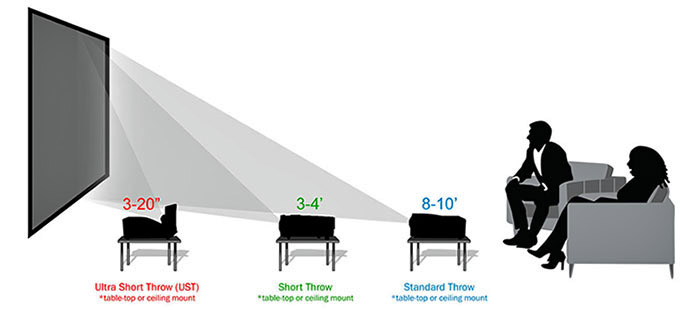
An Ultra Short Throw (UST) projector can be placed just a few inches away from the front wall and still get an enormous image: 100 inches diagonal or even larger. UST projectors use special optical assemblies and processors to create a high quality, high resolution image without geometric distortion, without the space requirements of a traditional projector. UST Projectors are for those who want a huge screen movie theater experience at home for a fraction of the cost of a full scale high-end home theater projection system or a giant flat panel TV.
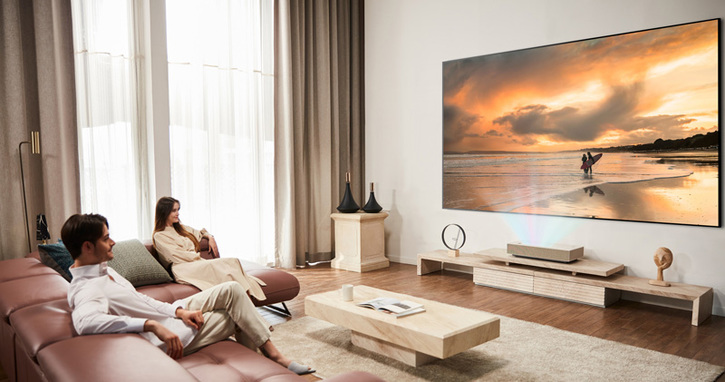
UST projectors are sometimes referred to as "Laser TVs" because they use one or more lasers as the light source. Hisense was the first to coin that phrase, but now the term "Laser TV" is used by many to describe laser-powered UST projectors. Laser light sources are superior to traditional lamps in that they are expected to last 20,000 hours or more without any need for lamp replacement. Also, because the projector itself goes in front of the viewer, a UST projector cabinet can include its own built-in powered speakers. So you may not need to buy a separate soundbar or component system to handle the sound. Of course, we'd always recommend investing in a good home theater sound system so you can get the BIG SOUND to match that BIG PICTURE. But I digress...
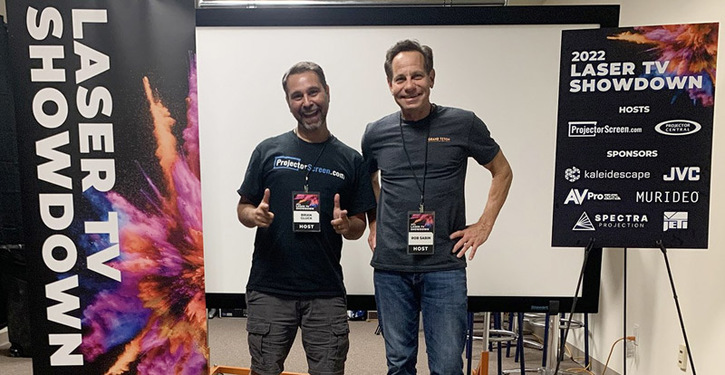
Before the event, all UST projectors in the shootout were calibrated for their top performance by professional calibrators, and all Triple Laser models used identical screens: a 100" Spectra Projection Vantage ambient light rejecting screen. This screen was engineered specifically for use with UST projectors. Content varied among test patterns, test videos and movie clips, each selected to highlight a particular challenge in image reproduction. The judges considered color accuracy and saturation, upscaling and deinterlacing, image uniformity, geometry, brightness, contrast, black level performance and shadow detail (among other things). I'm sure the judges and event organizers were exhausted at the end of the day. I'm getting tired just writing about it.
Rob Sabin, Editor in Chief of Projector Central emceed the event, along with a little help from Brian Gluck, President of ProjectorScreen.com. The judging panel was comprised of six individuals from diverse backgrounds, all with deep knowledge and expertise in the home theater projector space.
In order to view the projectors' performance under the most common lighting conditions, and with a variety of content, each projector was calibrated for three different modes: SDR Day (Standard Dynamic Range Bright Room), SDR Dark Room and HDR (High Dynamic Range) Dark Room. Event hosts set each projector to the appropriate calibration preset for the separate groups of test material. By the way, if you buy one of these projectors, or really any high quality projection display, we'd recommend hiring a professional calibrator so that you can also get the best performance out of your projector. One size calibration does not fit all in the projector world, and a poorly calibrated display can really kill that home theater vibe.
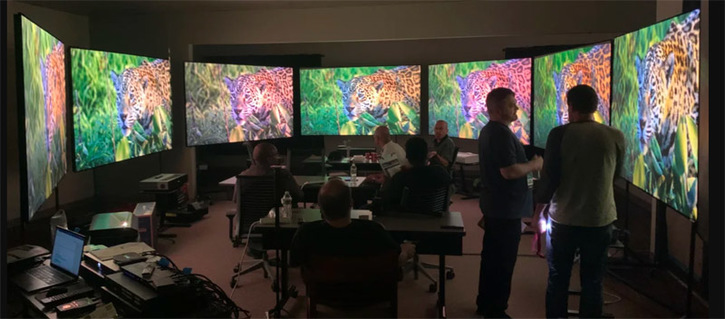
On the morning of August 4th, the judges cast their eyes upon the eight single laser-driven competitors. They stared, they squinted, they scribbled notes and discussed deep meaningful things like Color Gamut, Soap Opera Effect and HDR Tone Mapping. After lunch, and giving their tired eyes a rest, the judges resumed their judginess with the six triple-laser competitors. Results of the competition were a bit surprising, at least for me. While the winner of the single laser event was from an established brand in the projection space, the winner of the triple laser competition was from a company I'd never even heard of before. And I like to think I pay attention to these things (well, most of the time anyway... Squirrel!).
The top spot in the Triple Laser competition went to the Formovie Theater UST projector. Also known as the Fengmi T1, this is a 4K DLP-based projector, rated for 2800 Lumens and priced at an affordable $2999.99 (the least expensive Tri-Laser projector in the bunch). The Formovie was extremely highly rated for color accuracy, contrast and motion reproduction. It also excelled at HDR tone mapping, which is the ability to map high dynamic range content to the specific luminance capabilities of the projector.
Although Dolby Vision capability wasn't one of the test criteria, the Formovie was the only projector among the Triple Laser models to include Dolby Vision support. So Dolby Vision content on Ultra HD Blu-ray Discs and streaming services should look particularly good on this projector. However, the Trimovie isn't perfect. It featured a relatively poor lag time of 41.9 ms, meaning it may not be the best choice for serious gamers. It also lacks support for 3D, so if that's something that matters to you, you'll have to look elsewhere.
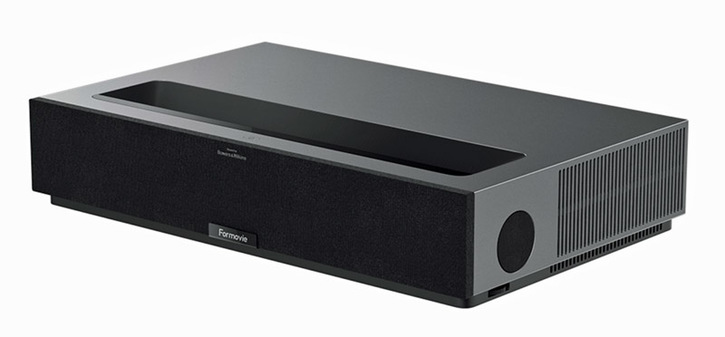
The Formovie projector beat out the LG HU915QB by the slimmest of margins with an overall score of 9.08 compared to the LG projector's 9.01. The LG ranked particularly highly in bright room viewing so it may make a great choice if dimming the room lights is inconvenient. But the LG projector sells for $6,499 - more than twice the price of the Formovie - so that's another point to consider.
The HiSense PX1-Pro received an honorable mention with an overall score of 8.94. The HiSense projector received the highest overall scores for motion reproduction, color accuracy in SDR reference mode and UHD Detail. It also featured one of the better motion lag scores in the group with 38.1 ms, making it a potentially better choice for gamers.
These top three Triple laser projectors all ranked highly and each would make a great choice as the centerpiece of a home theater or media room. Find out more about the three top rated triple laser projectors on ProjectorScreen.com's web site:
The best UST projector in the single laser category was BenQ's V7050i. It's a 4K DLP-based projector rated for 2500 Peak Lumens, priced at $3499.99. The BenQ scored highly on brightness and contrast tests. It also was highly rated for color accuracy, skin tone reproduction and motion reproduction. Like the Formovie projector, the BenQ didn't have a great motion lag score. In fact, it was near the bottom at a whopping 69.1 ms of lag time. If you're not into gaming though, this spec isn't relevant. 3D fans will be happy to hear that the BenQ projector does support 3D via optional active 3D Glasses. The BenQ V7050i actually had the highest overall score in the competition, a 9.15 out of 10 - a few hundredths of a point above the Formovie triple laser model.
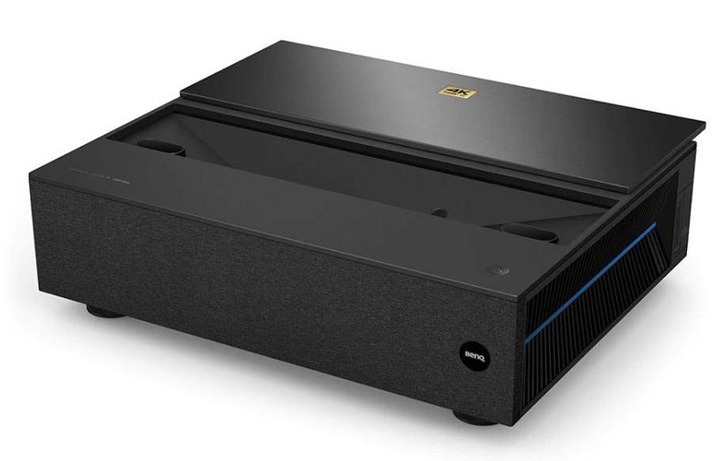
In second place in the single laser competition was the HiSense 100L5G with 8.9 out of 10. And while the Hisense projector sells for $500 more than the BenQ, the Hisense comes with a 100" screen bundled in for that price. Considering that most good UST projector screens sell for over $1,000, the Hisense projector/screen bundle offers excellent value. The HiSense projector does not include 3D support.
Honorable mention in the single laser category went to the Viewsonic X2000B with an overall score of 8.83 out of 10, just 7 hundredths of a point below the Hisense projector. The Viewsonic projector received the highest score for color accuracy in SDR Day Mode and also includes 3D capability.
Also worth noting is the single laser UST category is the only LCD projector in the competition, the Epson LS500. Though its overall score (8.47/10) placed if fifth overall, the projector had the highest brightness rating (4000 Lumens), as well as the lowest lag time by far at 21.1 ms. This would make the Epson a great choice for gaming. The Epson also supports 3D content via optional active shutter 3D glasses.
You can find out more about these single laser UST projectors here:
Those who are seriously shopping for a UST projector will want to spend some time and check out the complete results and scorecards on ProjectorScreen.com's web site. The competition was a close one in both the Tri-Laser and Single Laser categories and there may be specific picture quality elements, features or aesthetics that matter to you more than others: